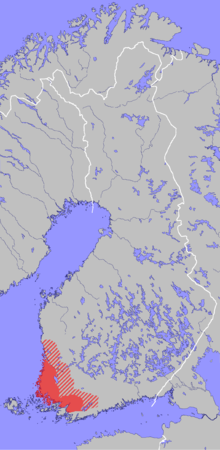| Southwest Finnish dialects | |
|---|---|
| Lounaismurteet | |
Uralic
| |
| Language codes | |
| ISO 639-3 | – |
| Glottolog | sout2677 |
 The areas in which the Southwest Finnish dialects are traditionally spoken. | |
Southwest Finnish dialects (Finnish: Lounaismurteet) are Western Finnish dialects spoken in Southwest Finland and Satakunta.[1]

The Southwest Finnish dialects have pitch accents and Swedish influences, as well as features from other dialect groups (especially Tavastian).[3][4][5] However, features and influences from other Finnish dialect groups are largely absent in the Rauma dialect.[6]
The Southwest Finnish dialects can be divided into two subgroups, Northern and Eastern groups, which in turn can be divided into even smaller groups. Heikki Ojansuu divided the Northern group into three: Rauma, Taivassalo and Masku groups, and the Eastern group into two: Halikko and Coastal groups.
- ^ "Lounaismurteiden piirteitä". sokl.uef.fi.
- ^ Salokangas, R.K.R.; Svirskis, T.; Heinimaa, M.; Huttunen, J.; Ristkari, T.; Ilonen, T.; Hietala, J. (October 2006). "0054 Personality Features and Vulnerability to Psychosis. Results of the Deep Project". Schizophrenia Research. 86: S83. doi:10.1016/s0920-9964(06)70249-3. ISSN 0920-9964. S2CID 54243541.
- ^ "Eurajoen murrepiirteitä". Kotimaisten kielten keskus (in Finnish). Retrieved 2021-05-29.
- ^ "Unohtunut Turun murre kansien väliin". aamuset.fi (in Finnish). Retrieved 2021-05-29.
- ^ "Lounaismurteiden piirteitä". sokl.uef.fi.
- ^ Kalevi, Wiik (2004). Suomen Murteet Kvanttinen tutkimus. Helsinki: Suomalaisen Kirjallisuuden seura. pp. 60–75.
